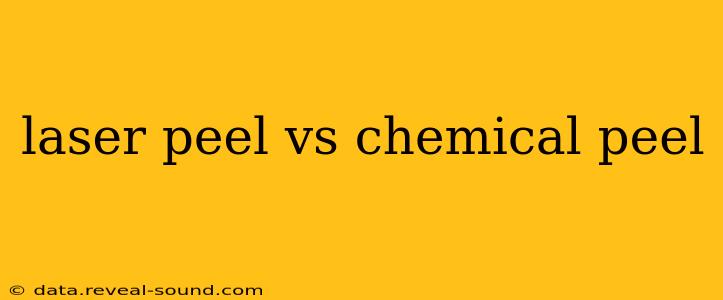Choosing between a laser peel and a chemical peel can feel overwhelming. Both procedures aim to rejuvenate the skin, reducing wrinkles, acne scars, and age spots, but they achieve this through different mechanisms. This comprehensive guide will explore the key differences between laser peels and chemical peels, helping you make an informed decision about which treatment best suits your needs and skin type.
What is a Laser Peel?
A laser peel uses a highly concentrated beam of light to ablate (remove) the outer layers of skin. Different types of lasers target different depths, allowing for customized treatments ranging from superficial resurfacing to deeper peels. This controlled damage stimulates collagen and elastin production, leading to improved skin texture, tone, and reduced wrinkles.
Types of Laser Peels:
- Ablative Laser Peels: These penetrate deeper into the skin, removing more tissue. They offer more dramatic results but require a longer recovery period. Examples include CO2 and Erbium:YAG lasers.
- Non-Ablative Laser Peels: These treatments penetrate less deeply and cause less damage, leading to a faster recovery time. While less dramatic, they still offer significant improvements in skin texture and tone. Fraxel lasers are a common example.
What is a Chemical Peel?
A chemical peel uses a chemical solution to exfoliate the skin. The solution causes controlled damage to the outer layers, prompting the skin to regenerate new, healthier cells. The depth of the peel depends on the type and concentration of the chemical solution used.
Types of Chemical Peels:
- Superficial Peels: These use mild acids like alpha-hydroxy acids (AHAs) and salicylic acid, targeting the outermost layer of the skin. They offer minimal downtime and are suitable for addressing mild skin concerns like acne and hyperpigmentation.
- Medium Peels: These use stronger acids like trichloroacetic acid (TCA), penetrating deeper into the skin and addressing more significant issues like wrinkles and sun damage. Recovery time is longer than with superficial peels.
- Deep Peels: These utilize the strongest chemical solutions, often phenol, and penetrate the deepest layers of the skin. They are reserved for severe cases of wrinkles and sun damage and require significant downtime.
Laser Peel vs. Chemical Peel: Key Differences
| Feature | Laser Peel | Chemical Peel |
|---|---|---|
| Mechanism | Laser light removes skin layers | Chemical solution exfoliates skin layers |
| Precision | Highly precise targeting of specific areas | Less precise targeting, potentially affecting surrounding areas |
| Depth of Peel | Variable, from superficial to deep | Variable, from superficial to deep |
| Downtime | Varies depending on depth of peel | Varies depending on depth of peel |
| Cost | Generally more expensive | Generally less expensive |
| Suitable for | Wrinkles, acne scars, sun damage, uneven tone | Wrinkles, acne scars, sun damage, uneven tone, acne |
Which Treatment is Right for Me?
The best treatment depends on several factors, including:
- Your Skin Type: Certain skin types may be more suitable for one treatment over another.
- Your Skin Concerns: The severity of your wrinkles, acne scars, or other skin issues will influence the choice.
- Your Budget: Laser peels are typically more expensive than chemical peels.
- Your Downtime Tolerance: Consider your lifestyle and how much downtime you can afford.
How Long Does Recovery Take After Each Procedure?
Recovery Time for Laser Peels: Recovery time varies greatly depending on the type of laser used. Non-ablative laser peels often have minimal downtime, with redness subsiding within a few days. Ablative laser peels, however, can result in significant swelling, redness, and scabbing, requiring several weeks to heal.
Recovery Time for Chemical Peels: Similar to laser peels, recovery time depends on the depth of the peel. Superficial peels typically heal within a few days, while medium and deep peels require several weeks for complete healing.
Are There Any Potential Side Effects?
Both laser peels and chemical peels carry potential side effects, including:
- Infection: Proper aftercare is crucial to minimize infection risk.
- Scarring: Although rare, scarring is a potential risk, especially with deeper peels.
- Changes in Skin Pigmentation: Hyperpigmentation (darkening) or hypopigmentation (lightening) can occur.
- Redness and Swelling: These are common, temporary side effects.
Ultimately, the best way to determine which treatment is right for you is to consult with a qualified dermatologist or cosmetic surgeon. They can assess your skin, discuss your goals, and recommend the most appropriate and safe treatment plan. They can also address any specific questions or concerns you may have.
